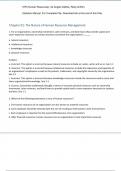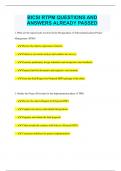(HR (Human Resources), 5e Angelo DeNisi, Ricky Griffin)
(Solution Manual, For Complete File, Download link at the end of this File)
Chapter 01: The Nature of Human Resource Management
1. For an organization, ownership investment, sales revenues, and bank loans that provide capital and
cover expenses necessary to conduct business constitute the organization's _____.
a. natural resources
b. intellectual resources
c. knowledge resources
d. physical resources
Analysis:
a. Incorrect. This option is incorrect because natural resources include air, water, wind, and so on. See 1-1
b. Incorrect. This option is incorrect because intellectual resources include the experience and expertise of
an organization's employees as well as the patents, trademarks, and copyrights owned by the organization.
See 1-1
c. Incorrect. This option is incorrect because knowledge resources include the resources used to store and
share organizational knowledge. See 1-1
d. Correct. Economists traditionally thought in terms of concrete physical resources such as ownership
investment, sales revenues, and bank loans to provide capital and to cover expenses necessary to conduct
business. See 1-1
2. Which of the following statements is true of human resources?
a. The human resources of an organization are also known as material resources.
b. Each employee should be selected with the aim of creating an ethnocentric work environment.
c. Each employee is important to the overall effectiveness of an organization.
d. After financial resources, human resources are an organization's most important resources.
© 2020 Cengage Learning. All Rights Reserved. May not be scanned, copied or duplicated, or posted to a publicly accessible website, in whole or in part.
,Analysis:
a. Incorrect. Human resources include everyone from the CEO, who is responsible for the overall
effectiveness of an organization, to the custodian who cleans the offices after everyone else goes home.
Each employee, in his or her own way, is a vital ingredient that helps determine the overall effectiveness—
or lack of effectiveness—of the organization as it strives to accomplish its goals and objectives. See 1-1
b. Incorrect. Human resources include everyone from the CEO, who is responsible for the overall
effectiveness of an organization, to the custodian who cleans the offices after everyone else goes home.
Each employee, in his or her own way, is a vital ingredient that helps determine the overall effectiveness—
or lack of effectiveness—of the organization as it strives to accomplish its goals and objectives. See 1-1
c. Correct. Human resources include everyone from the CEO, who is responsible for the overall
effectiveness of an organization, to the custodian who cleans the offices after everyone else goes home.
Each employee, in his or her own way, is a vital ingredient that helps determine the overall effectiveness—
or lack of effectiveness—of the organization as it strives to accomplish its goals and objectives. See 1-1
d. Incorrect. Human resources include everyone from the CEO, who is responsible for the overall
effectiveness of an organization, to the custodian who cleans the offices after everyone else goes home.
Each employee, in his or her own way, is a vital ingredient that helps determine the overall effectiveness—
or lack of effectiveness—of the organization as it strives to accomplish its goals and objectives. See 1-1
3. _____ refers to the comprehensive set of managerial activities and tasks concerned with attracting,
developing, and maintaining a qualified workforce in ways that contribute to organizational effectiveness.
a. Human resource management
b. Scientific management
c. Information management
d. Operations management
Analysis:
a. Correct. Human resource management refers to the comprehensive set of managerial activities and tasks
concerned with attracting, developing, and maintaining a qualified workforce—human resources—in ways
that contribute to organizational effectiveness. See 1-1
b. Incorrect. This option is incorrect because scientific management was concerned with structuring
individual jobs to maximize efficiency and productivity. See 1-1
c. Incorrect. This option is incorrect because information management is the process of acquiring,
organizing, and maintaining information. See 1-1
© 2020 Cengage Learning. All Rights Reserved. May not be scanned, copied or duplicated, or posted to a publicly accessible website, in whole or in part.
,d. Incorrect. This option is incorrect because operations management is concerned with planning and
controlling various operations of a business to ensure efficiency. See 1-1
4. The passage of _____ made it clear that organizations had to find ways to hire, reward, and manage
people effectively within the limits of the law.
a. Title VII of the Civil Rights Act of 1964
b. Section 5 of the Occupational Safety and Health Act of 1970
c. the Labor Management Relations Act of 1947
d. the Worker Adjustment and Retraining Notification Act of 1989
Analysis:
a. Correct. The passage of Title VII of the Civil Rights Act of 1964 (and various court decisions that followed
it) made it clear that organizations had to find ways to hire, reward, and manage people effectively within
the limits of the law. As a result, the human resource management function came to require dedicated
professionals who could balance legal and ethical concerns with the need of organizations to survive and be
profitable. See 1-1
b. Incorrect. The passage of Title VII of the Civil Rights Act of 1964 (and various court decisions that
followed it) made it clear that organizations had to find ways to hire, reward, and manage people
effectively within the limits of the law. As a result, the human resource management function came to
require dedicated professionals who could balance legal and ethical concerns with the need of
organizations to survive and be profitable. See 1-1
c. Incorrect. The passage of Title VII of the Civil Rights Act of 1964 (and various court decisions that
followed it) made it clear that organizations had to find ways to hire, reward, and manage people
effectively within the limits of the law. As a result, the human resource management function came to
require dedicated professionals who could balance legal and ethical concerns with the need of
organizations to survive and be profitable. See 1-1
d. Incorrect. The passage of Title VII of the Civil Rights Act of 1964 (and various court decisions that
followed it) made it clear that organizations had to find ways to hire, reward, and manage people
effectively within the limits of the law. As a result, the human resource management function came to
require dedicated professionals who could balance legal and ethical concerns with the need of
organizations to survive and be profitable. See 1-1
5. _____ are an organization's most important resources.
a. Physical resources
© 2020 Cengage Learning. All Rights Reserved. May not be scanned, copied or duplicated, or posted to a publicly accessible website, in whole or in part.
, b. Natural resources
c. Human resources
d. Monetary resources
Analysis:
a. Incorrect. Material resources such as factories, equipment, raw materials, computers, and offices play an
important role in the actual creation of goods and services and are easy to think about when one discusses
a firm's resources. But managers are beginning to view less tangible resources as the most critical for
gaining a competitive advantage. See 1-1
b. Incorrect. Natural resources play an important role in the actual creation of goods and services and are
easy to think about when one discusses a firm's resources. But managers are beginning to view less
tangible resources as the most critical for gaining a competitive advantage. See 1-1
c. Correct. Human resources are an organization's most important resources. Hiring the right people,
equipping them with the right skills, and then providing an environment in which they can truly contribute
can substantially affect the quality and quantity of whatever goods or services the organization produces.
See 1-1
d. Incorrect. Monetary resources play an important role in the actual creation of goods and services and are
easy to think about when one discusses a firm's resources. But managers are beginning to view less
tangible resources as the most critical for gaining a competitive advantage. See 1-1
6. Which of the following statements is true of contemporary human resource management (HRM)?
a. The importance of HRM activities is decreasing because of the growing realization of the importance of
technology as a source of competitive advantage.
b. Contemporary HRM is concerned exclusively with hiring first-line employees such as production workers,
blue-collar workers, and other operating employees.
c. The view of HRM as part of the legal enforcement arm of an organization is largely applicable only in the
United States.
d. Contemporary HRM policies are aimed at promoting ethnocentrism in the workplace.
Analysis:
a. Incorrect. The view of HRM as part of the legal enforcement arm of an organization is largely applicable
only in the United States. Yet managers around the world have come to understand that properly managed
human resources can be an important source of competitive advantage in an increasingly competitive
world. See 1-1
© 2020 Cengage Learning. All Rights Reserved. May not be scanned, copied or duplicated, or posted to a publicly accessible website, in whole or in part.





